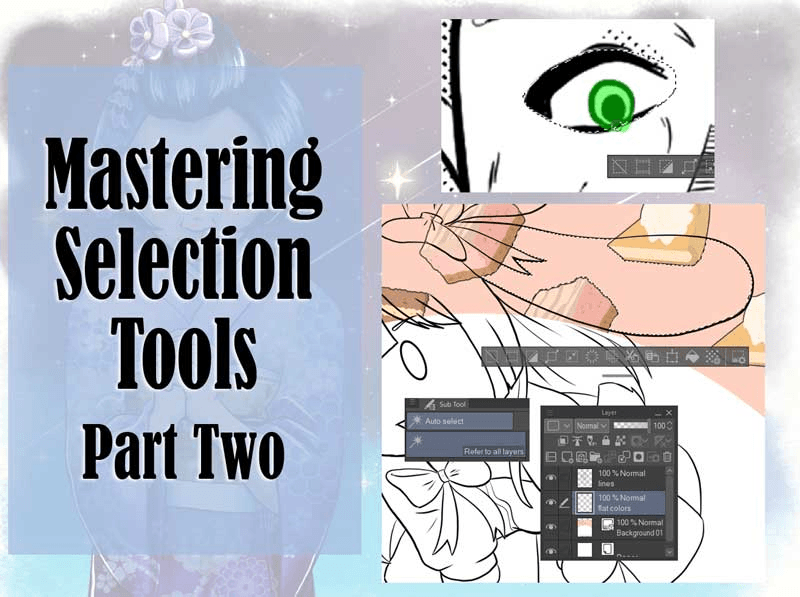Basics of Using 3D Primitives
Hello! My name is Liz Staley and I’m a long-time user of Clip Studio Paint (I started using the program back when it was known as Manga Studio 4!). I was a beta-tester on the Manga Studio 5 program and for Clip Studio Paint, and I have written three books and several video courses about the program. Many of you probably know my name from those books, in fact. I write weekly posts on Graphixly.com and on CSP Tips, so be sure to come back every week to learn more Clip Studio Tips and Tricks from me!
One of the new features added in Clip Studio Paint Version 1.11.6 is the ability to add and do basic edits to various 3D Primitives. Though the current functionality of this feature is limited, you can still use these primitives in various combinations to create reference for things like backgrounds for your comics or illustrations! But how do we use these primitives?
In this article we will cover the following topics:
Adding Primitives to Your Canvas
Resizing and Rotating Primitives
Let’s dive right in!
Adding Primitives to Your Canvas
A primitive is a basic 3D shape, such as a square/rectangle, sphere, cone, cylinder, or plane. In more advanced 3D modeling programs you can build very complicated shapes from primitives. Clip Studio Paint has limited editing with these primitives, but you can still do enough with them to build basic scenes, like room interiors or cityscapes, to then use for reference for your images.
We can find Primitives in the Material Library, unde 3D > Primitives.
For this tutorial we aren’t going to be using the Billboard primitive, just the ones beneath it. To add a Primitive to your canvas, simply click on the one you want to use and then drag it to your canvas (or click the “Paste selected to canvas” icon at the bottom of the Material Library window).
(If you don’t see Primitives in your Material Library, make sure that you have upgraded to CSP Version 1.11.6 by going to the Clip Studio website and downloading and installing the latest version.)
Now that the Primitive is on our canvas we can edit and move around it to fit it to our needs. Let’s cover that in our next section!
Resizing and Rotating Primitives
The default view for the Cube primitive looks more like we’re about to play a game of Tic-Tac-Toe than create a 3D object, but I promise that this is a 3D shape!
When you are working in CSP’s 3D space, you will see the blue icons that are showing at the top left of my square in the above screenshot. Using the leftmost three of these icons will allow you to move the virtual camera around to see your 3D objects from different views. The icons are: rotate, move up/down/left/right, and move in and out of the scene (think of it like zooming in and out).
The Tool Property window allows us to change some basic options on these primitives. This includes changing the number of subdivisions of the shape, showing or hiding the wireframe (the lines of subdivision), changing the color or adding a texture, and more.
In the screenshot below, I’ve moved the camera so that we can see three of the six sides of our cube. In the Tool Property window, click the + symbol next to the Sub-divisions option. On the cube, these subdivisions don’t really have much use except for reference, but you’ll see that on other shapes the number of subdivisions can make the primitive more or less smooth. However, one way you can use subdivisions on Cubes is to mark out evenly spaced reference lines.
For instance, if we were going to use this cube as a reference for a bookshelf with 5 shelves, we can make that many subdivisions on one axis (in the screenshot above the Y-axis has 5 subdivisions), then turn off subdivisions on the other two axises and resize the cube to be more like a bookshelf in shape. Let’s work toward this five-shelf bookshelf reference image while learning how to resize and manipulate this Primitive.
Using the Operation - Object subtool, click on the Primitive you want to edit to select it. It will show in blue and a new set of controls will show up in the middle of the shape. This set of controls is made of three sets of arrows, three circles, six cubes, and one large circle with four arrows sticking off of it surrounding all the controls.
The arrows in the middle of this set of controls allow you to change the position of the shape. Each set of color-coded arrows control the movement along one of three axises. To change the position of your shape, simply move the cursor over the arrows pointing in the direction you want to move it and make sure the arrow “lights up”, then click and drag.
The six color-coordinated cubes allow us to change the scale of the primitive in just one of the three axises. Move your mouse over one of the cubes until the cube changes to an orange color, then click and drag to push or pull the primitive along that axis. In the screenshot below I’ve pulled the blue cube closest to the camera (which is currently colored orange because it’s active) to make the cube into a rectangle.
However, since I want to use the side of this cube with 5 subdivisions as a reference for a bookshelf, I actually want to push this side in instead.
Using the six cubes to control the proportions of the cube, I pushed and pulled until I had a tall but skinny shape more like a tall bookshelf, shown below.
The inner circular controls are like the arrow controls, except that they allow you to change the rotation of the object, one axis at a time. To rotate the currently selected object, choose the direction you want to rotate in and then locate the circle that is in that direction. Move the cursor over that circle until it turns orange, then click and drag to rotate.
The final set of these primitives controls is the large circle with the four little arrows off of it. This control changes the scale of the entire selected Primitive at once. It is used in the same way as the other controls we’ve discussed in this section, but allows us to scale the shape while keeping the overall proportions.
By scaling, rotating, positioning, and subdividing various Primitives, you can combine shapes to create basic items. The lamp in the image below is made of three prism shapes - one for the base, one for the pole, and one for the lampshade. The Prism for the base and pole have been subdivided the maximum number of times for this shape to get a rounder look. The walls and floor are three Plane primitives that I’ve applied materials to.
In just a few minutes you can create an entire scene to use in your work!
Conclusion
This new feature is really exciting for those of us who aren’t proficient at other, more complex, 3D modeling software. At the moment you won’t be able to replace models made in other software, but you can throw together a basic shape for a quick reference and I think that’s great!
For more information on CLIP Studio Paint, please visit https://www.clipstudio.net/en or https://graphixly.com



















Comment